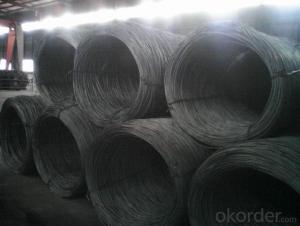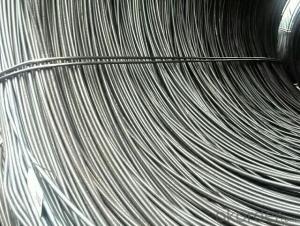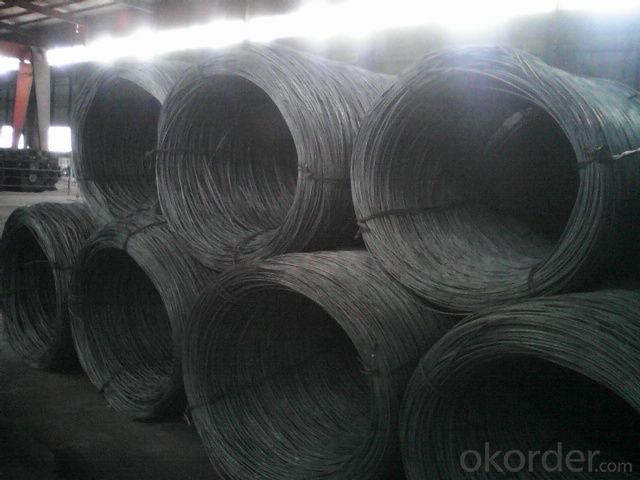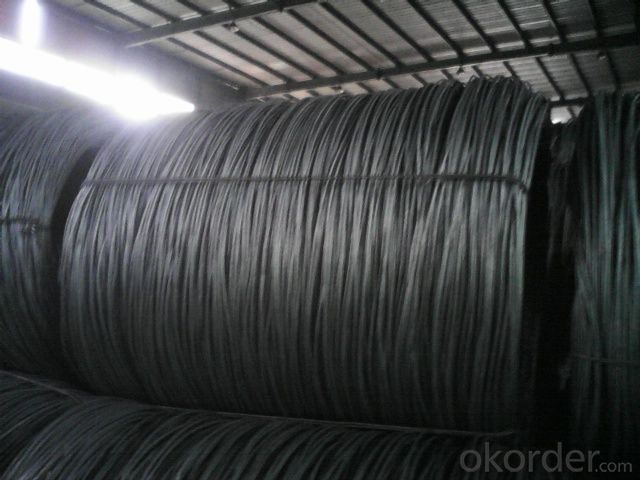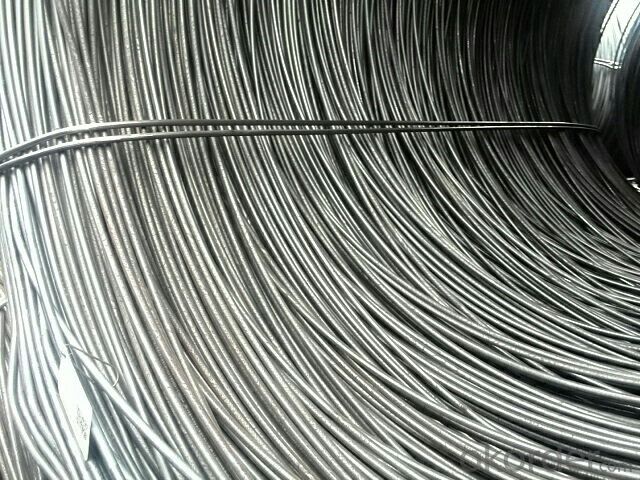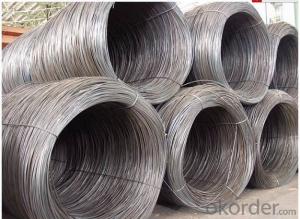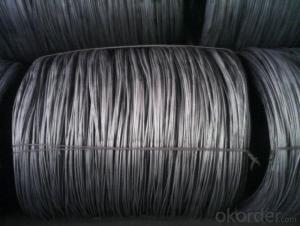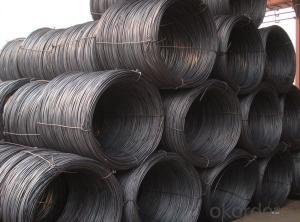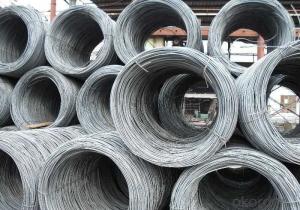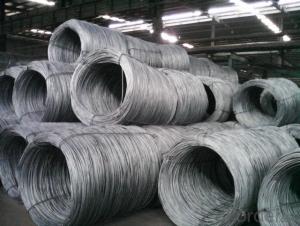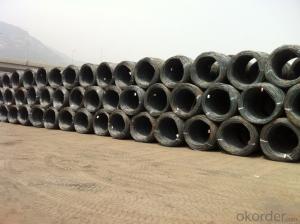Wire Rod Sae1006B and Q235 with High quality
- Loading Port:
- Tianjin
- Payment Terms:
- TT or LC
- Min Order Qty:
- 25 m.t
- Supply Capability:
- 20000 m.t/month
OKorder Service Pledge
OKorder Financial Service
You Might Also Like
Product Description:
OKorder is offering Wire Rod Sae1006B and Q235 with High quality at great prices with worldwide shipping. Our supplier is a world-class manufacturer of steel, with our products utilized the world over. OKorder annually supplies products to European, North American and Asian markets. We provide quotations within 24 hours of receiving an inquiry and guarantee competitive prices.
Product Applications:
Wire Rod Sae1006B and Q235 with High quality ideal for structural applications and are widely used in the construction of buildings and bridges, and the manufacturing, petrochemical, and transportation industries.
Product Advantages:
Wire Rod Sae1006B and Q235 with High quality are durable, strong, and resist corrosion.
Main Product Features:
· Premium quality
· Prompt delivery & seaworthy packing (30 days after receiving deposit)
· Corrosion resistance
· Can be recycled and reused
· Mill test certification
· Professional Service
· Competitive pricing
Product Description:
Specifications of Wire Rod Sae1006B and Q235 with High quality :
Steel Grade: sae1006+sae1008B , Standard: GB Diameter: 5.5mm, 6.5mm, 7mm,8mm,9mm,10mm,12mm,14mm
Diameter Tolerance:±0.3mm 6.5mm can be drawing into 2mm/8.0mm can be drawing into 3mm
Brand Name: N-RIVER Place of Origin: Hebei, China Mainland Application: construction, building etc
Chemical Composition:
Please kindly find our chemistry of our material based on Q235 as below for your information
Trademark | Rank | Chemical composition (quality score) % | ||||||
C | Si | Mn | S | P | ||||
| ≤ |
| ≤ | ≤ | ||||
Q235 | A | 0.14-0.22 | 0.30 | 0.30-0.65 | 0.050 | 0.045 | ||
Q235 | B | 0.12-0.20 | 0.30 | 0.30-0.70 | 0.045 | 0.045 | ||
Trademark | Rank | Pulling Test | ||||||
Bend PointΔs/Mpa | Tensile Strength | Elongation Ratioδ5% | ||||||
Thickness (Diameter) /MM | Thickness (Diameter) /MM | |||||||
≤16 | 16-40 | ≤16 | 16-40 | |||||
≥ | ≥ | |||||||
Q235 | A | 235 | 225 | 375-500 | 26 | 25 | ||
Q235 | B | 235 | 225 | 375-500 | 26 | 25 | ||
Usage and Applications of Wire Rod Sae1006B and Q235 with High quality :
After hot-rolled the products shaped into coil and delivery as finished product, including round, square, rectangular, hexagonal and so on. Since most of the products are round, it is generally called wire rod. Carbon steel wire rod is widely used in construction and manufacturing. Carbon steel wire rod is mainly used for reinforcement of reinforced concrete and welded structure or reprocessed (roberts , nail, etc.) materials, especially used to produce wire drawing, welding electrode, nails, spring, electronic, precise machinery parts and so on.
Packaging & Delivery of Wire Rod Sae1006B and Q235 with High quality :
Packaging Detail: products are packed in coil and then shipped by container or bulk vessel
Each coil weight: 2-3MT
Delivery Detail: within 45 days after received deposit or LC.
Label: to be specified by customer, generally, each bundle has 1-2 labels
Trade terms: FOB, CFR, CIF
FAQ:
Q1: Why buy Materials & Equipment from OKorder.com?
A1: All products offered byOKorder.com are carefully selected from China's most reliable manufacturing enterprises. Through its ISO certifications, OKorder.com adheres to the highest standards and a commitment to supply chain safety and customer satisfaction.
Q2: How do we guarantee the quality of our products?
A2: We have established an advanced quality management system which conducts strict quality tests at every step, from raw materials to the final product. At the same time, we provide extensive follow-up service assurances as required.
Q3: How soon can we receive the product after purchase?
A3: Within three days of placing an order, we will begin production. The specific shipping date is dependent upon international and government factors, but is typically 7 to 10 workdays.
Images:
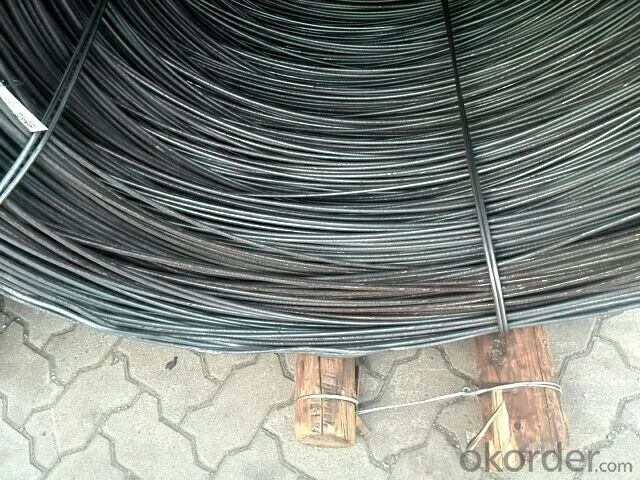
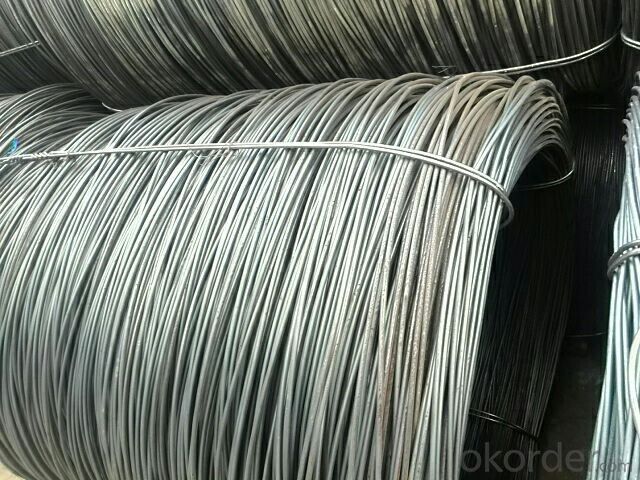
- Q: What are the advantages of using steel wire rod in mining applications?
- There are several advantages to using steel wire rods in mining applications. Firstly, steel wire rods offer high tensile strength, making them capable of withstanding heavy loads and extreme conditions commonly encountered in mining operations. Additionally, steel wire rods are highly durable and resistant to corrosion, ensuring a longer lifespan and reduced maintenance costs. Moreover, the flexibility of steel wire rods makes them suitable for various mining applications, such as reinforcing tunnels, supporting mine shafts, and even securing equipment. Overall, the use of steel wire rods in mining enhances safety, efficiency, and overall productivity.
- Q: What are the major growth strategies adopted by companies in the steel wire rod industry?
- In the steel wire rod industry, companies adopt various growth strategies to expand their market share and increase their profitability. Some of the major growth strategies adopted by companies in this industry include: 1. Market Expansion: Companies focus on expanding their market reach by targeting new geographic regions or entering new market segments. This strategy involves investing in market research and developing new distribution channels to reach a wider customer base. 2. Product Innovation: Steel wire rod companies constantly invest in research and development to develop new and improved products. They strive to stay ahead of the competition by offering innovative solutions that cater to the evolving needs and preferences of customers. This strategy helps companies capture new customers and retain existing ones. 3. Vertical Integration: Some companies in the steel wire rod industry adopt a vertical integration strategy by acquiring or investing in companies involved in the upstream or downstream processes of the industry. By integrating backward or forward in the value chain, companies can gain more control over their supply chain, reduce costs, and enhance their competitiveness. 4. Strategic Partnerships and Alliances: Collaborating with other industry players through strategic partnerships and alliances can be an effective growth strategy. Companies can benefit from shared resources, knowledge exchange, and joint marketing efforts, which can lead to increased market penetration and customer acquisition. 5. Mergers and Acquisitions: Mergers and acquisitions are common in the steel wire rod industry as companies seek to consolidate their market position and achieve economies of scale. By acquiring or merging with other companies, they can eliminate competition, access new markets, and diversify their product offerings. 6. Diversification: Steel wire rod companies may also adopt a diversification strategy by expanding into related industries or product lines. This strategy allows companies to reduce their dependence on a single market and mitigate risks associated with market fluctuations. For example, a company may diversify into manufacturing wire mesh or wire products for different industries. 7. Operational Efficiency: Improving operational efficiency is a crucial growth strategy for companies in the steel wire rod industry. By investing in advanced technologies, automation, and lean manufacturing practices, companies can reduce costs, increase productivity, and improve overall profitability. It is important to note that the specific growth strategies adopted by companies in the steel wire rod industry may vary depending on their size, resources, and market dynamics. However, these strategies provide a general overview of the major approaches employed by companies to achieve growth and success in this highly competitive industry.
- Q: How is steel wire rod used in the production of wire for mattress springs?
- Steel wire rod is an essential element when producing wire for mattress springs. It acts as the primary raw material used to manufacture the robust and long-lasting wire required for mattress springs. To initiate the manufacturing process, careful selection of steel wire rod is crucial, considering its desired characteristics such as tensile strength, flexibility, and corrosion resistance. Subsequently, the rod undergoes a series of procedures to convert it into wire suitable for mattress springs. The initial step involves heating the steel wire rod and passing it through a sequence of dies that gradually reduce its diameter. This process, known as wire drawing, refines the mechanical properties of the wire and ensures uniformity in thickness. Once the wire has been drawn to the desired diameter, it undergoes further treatment to enhance its strength and resilience. This may involve heat treatment procedures like annealing or quenching, which improve the wire's flexibility and resistance to fatigue. Following the treatment, the wire is coiled onto spools or reels, ready for use in the manufacturing of mattress springs. The wire is then fed into specialized spring-making machinery, where it is shaped into the required size and shape. These machines utilize a combination of bending, coiling, and twisting movements to create the intricate spring designs commonly found in mattresses. The utilization of high-quality steel wire rod in the production of wire for mattress springs ensures that the springs are strong, durable, and capable of withstanding the constant pressure and weight placed upon them. Consequently, mattresses made with these springs provide excellent support and comfort to sleepers. In conclusion, steel wire rod plays a vital role in the production of wire for mattress springs. It undergoes various processes to refine its properties and is then shaped into the necessary form to create robust and resilient springs. This guarantees that mattresses manufactured with these springs offer superior support and durability to users.
- Q: How is steel wire rod used in the manufacturing of wire for underground cable systems?
- Steel wire rod is a crucial component in the manufacturing process of wire used in underground cable systems. The steel wire rod serves as the primary raw material that is transformed into the final wire product. The production process begins with the steel wire rod being subjected to various mechanical and heat treatments to enhance its strength and durability. Once the steel wire rod has been processed, it is then drawn through a series of dies to reduce its diameter and increase its length. This drawing process helps to refine the wire's mechanical properties, such as its tensile strength and flexibility, making it suitable for underground cable applications. The drawn steel wire is then further processed to ensure it meets the specific requirements for underground cable systems. This may involve applying a protective coating, such as zinc or polymer, to enhance corrosion resistance and insulation properties. Additionally, the wire may undergo further heat treatment processes, such as annealing, to relieve internal stresses and improve its overall performance. Finally, the finished wire is wound onto spools or reels, ready to be used in the manufacturing of underground cable systems. The wire is typically combined with other components, such as insulation materials and protective layers, to form a complete cable assembly. These cables are then installed underground to facilitate the transmission of electricity, telecommunications signals, or data. Overall, steel wire rod plays a vital role in the manufacturing process of wire for underground cable systems. It provides the necessary strength, flexibility, and durability required for these cables to withstand the harsh underground environments while ensuring efficient transmission of power or information.
- Q: How is steel wire rod straightened and cut to length?
- Steel wire rod is straightened and cut to length using a combination of mechanical and automated processes. Firstly, the wire rod is passed through a series of straightening rolls that apply pressure to remove any bends or kinks, ensuring a straight and uniform shape. Once straightened, the rod is fed into a cutting machine equipped with circular blades or shears, which precisely cut it to the desired length. This process ensures that steel wire rod is efficiently straightened and cut to meet specific requirements in various industries.
- Q: How are steel wire rods used in the production of wire coat hangers?
- Steel wire rods are an essential component in the production of wire coat hangers. These rods serve as the primary material for creating the sturdy and durable frame of the hanger. To begin the manufacturing process, the steel wire rods are first carefully selected based on their quality and strength. They are then fed into a wire drawing machine, which pulls the rods through a series of dies to reduce their diameter and increase their length. This process is known as wire drawing and helps to attain the desired thickness and shape for the coat hanger. Once the wire rods have been properly drawn, they are then cut into specific lengths based on the desired size of the hanger. These cut rods are then sent to a bending machine, where they are shaped into the familiar triangular form of a coat hanger. The bending process involves applying precise pressure and force to the wire rods, allowing them to take on the desired shape without losing their structural integrity. After the bending process, the wire coat hangers may undergo additional treatments, such as polishing or coating, to enhance their appearance and protect them from rust or corrosion. These finishing touches contribute to the overall aesthetic appeal and longevity of the hangers. In summary, steel wire rods are used as the main material in the production of wire coat hangers. They undergo a series of processes, including wire drawing and bending, to create the final product. These hangers provide a sturdy and reliable solution for organizing and hanging clothing items while maintaining their shape and durability over time.
- Q: What are the common documentation requirements for steel wire rod?
- The common documentation requirements for steel wire rod typically include the product specifications, test certificates, mill certificates, packing lists, and shipping documents such as bills of lading or airway bills. These documents provide crucial information about the quality, origin, and shipment of the steel wire rod, ensuring transparency and compliance with industry standards.
- Q: How are steel wire rods used in the production of barbed wire?
- Steel wire rods are a crucial component in the production of barbed wire. These rods serve as the raw material that is transformed into the sharp and durable barbs found on the wire. The manufacturing process involves taking the steel wire rods and passing them through a series of machines that form the wire into a specific shape, typically a twisted pattern with sharp barbs evenly spaced along its length. The steel wire rods used in barbed wire production must have specific properties to ensure the final product's effectiveness. They need to be strong, as barbed wire is often used for fencing and security purposes. The rods must also be flexible enough to be formed into the desired shape without breaking or losing their integrity. This is especially important as the wire is often stretched during installation, and any weakness or brittleness in the steel rods could lead to the wire breaking or becoming less effective as a security measure. Once the steel wire rods have been formed into the desired shape, they are usually galvanized to enhance their durability and resistance to corrosion. This involves applying a protective layer of zinc to the surface of the wire, which helps prevent rusting and ensures a longer lifespan for the barbed wire. Overall, steel wire rods are a fundamental element in the production of barbed wire. They provide the strength, flexibility, and durability necessary for creating effective fencing and security solutions. Without these rods, the production of barbed wire would not be possible, and the many applications of barbed wire, from agricultural use to perimeter security, would be significantly impacted.
- Q: How is the global steel wire rod market expected to grow?
- The global steel wire rod market is expected to experience steady growth in the coming years, driven by increasing demand from various end-use industries such as construction, automotive, and manufacturing. Factors such as urbanization, infrastructure development, and rising automotive production are likely to contribute to the market's growth. Additionally, technological advancements, product innovations, and the expansion of the construction sector in emerging economies are expected to further boost the market. However, challenges such as fluctuating raw material prices and stringent regulations may hinder the market's growth to some extent.
- Q: Is there any difference between wire rod and round steel in steel?
- Steel wire and round steel are two different materials.Wire rod refers to the hot-rolled steel bar of 5-22mm diameter or the special-shaped steel of this section. As a result of wire rod delivery, it is also known as wire rod.
Send your message to us
Wire Rod Sae1006B and Q235 with High quality
- Loading Port:
- Tianjin
- Payment Terms:
- TT or LC
- Min Order Qty:
- 25 m.t
- Supply Capability:
- 20000 m.t/month
OKorder Service Pledge
OKorder Financial Service
Similar products
Hot products
Hot Searches
Related keywords
